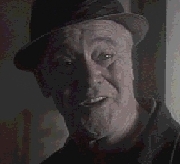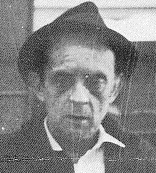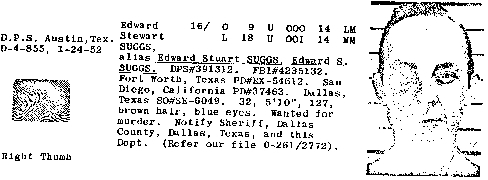The JFK 100
Who Was Jack Martin?

Jack Lemmon as JFK's key informant, Jack S. Martin

Jack Lemmon as JFK's key informant, Jack S. Martin
As presented by Oliver Stone, Jack Martin is a kindly old man -- a bit shifty and given to drink, but basically a trustworthy guy. Stone takes his cue from former New Orleans District Attorney Jim Garrison, who writes in his memoirs, "I had long regarded him [Jack Martin] as a quick-witted and highly observant, if slightly disorganized, private detective."(1)
This is something of a contrast, however, to remarks Garrison made to Life editor Richard Billings in December 1966 -- that Martin was "an undependable drunk,"(2) "a totally unreliable witness"(3) and "a liar"(4) -- someone who was such a notorious rumormonger and publicity-seeker in New Orleans, in fact, that Garrison specifically denied to the press Martin was a source of information for his JFK investigation.(5)
Aaron Kohn, head of New Orleans's Metropolitan Crime Commission, an influential citizens' watchdog committee, told the House Select Committee on Assassinations, "Jack Martin has always been a kind of harassing influence around here, somebody who wastes a lot of time, but you discover the best thing to do is to let him waste your time when he has things on his mind or else he wastes a lot more of your time when he gets drunk, waking you up in the middle of the night, threatening to kill you . . ."(6) "After years of all kinds of wild allegations," Kohn continues, ". . . I threw him out of my office . . ."(7)
Kohn also noted that Martin's real name was Suggs, and vaguely recalled his having been "incarcerated in an institution" on at least one occasion. (8)
Kohn's memory served him well.

Edward Stewart Suggs
a.k.a. Jack S. Martin
Jack S. Martin was born Edward Stewart Suggs on July 1, 1915, in Phoenix, Arizona. Suggs served in the Army during World War II, and later moved to California, where he unsuccessfully tried to become a police officer in Los Angeles and San Diego.(9)"Quick-witted and highly observant" private investigator Jack Martin also had a rap sheet stretching back to October 1944, and spanning the US from California to Arkansas to Texas to Louisiana. He was arrested in January 1945 in Fort Worth, Texas, for carrying a pistol; he was fingerprinted in Los Angeles in December 1945; he was arrested in December 1947 for disturbing the peace in San Diego and again in May 1949 in Dallas. He later would be investigated on numerous occasions for allegedly impersonating a doctor, an FBI agent, a CIA employee, a US Army colonel, and an ordained priest. Subsequent to his 1949 arrest, Suggs moved to Texas.(10)
In Houston, Suggs took up a new trade as practitioner of illegal abortions. In 1951, he fled the state when one of his unfortunate patients, one Helen Nichols, died shortly after undergoing an operation at the hands of "Dr. Suggs." A state grand jury indicted Suggs for murder in June of that year.(11)
Suggs was arrested in Los Angeles on May 2, 1953, as a fugitive from Texas, but he managed to get the murder charge dismissed. He would later describe his philosophy of life as, "The strong take from the weak and the smart take from the strong," and he "considers himself one of the smart." He related the details of the "'murder rap' he was involved in" and bragged that he "outsmarts everyone."(12)

In March 1954, Suggs was fingerprinted in Galveston, Texas, for vagrancy and a drunk-and-disorderly charge.(13) Soon after this, he moved to New Orleans and adopted the name, John Stewart Martin, Sr. He had difficulty holding a job and was largely supported by his wife, Paula. Concerned about his erratic behavior and excessive drinking, Mrs. Martin eventually insisted that her husband enter an alcohol treatment program in the Psychiatric Department of Charity Hospital.(14)In January 1957, Martin caused a disturbance in a New Orleans store and told store authorities he was an FBI agent. The FBI "instituted inquiries in this matter . . . and determined that he [Martin] was in a psychiatric ward [at] Charity Hospital, New Orleans as of January 17, 1957. His psychiatrist informed our agents that Suggs was suffering from a character disorder . . ."(15)
An 'Informative Note' in Martin's FBI file states, "Several sources have reported Martin is a mental case."(16) The actual diagnosis was "sociopathic personality disorder, antisocial type."(17)
Jim Garrison's onetime chief investigator, Pershing Gervais, describes Martin as "absolutely crazy."(18) According to Gervais, Martin "had a way of breathing up stories and being very positive about things. He would concoct things about someone and then he would talk to that someone" and construct a story "that would kind of jibe" with whatever new information he received. When asked about Martin's reliability, Gervais laughs and said, "He couldn't be reliable if he intended to be."(19)
NODA investigator Lynn Loisel -- who was nothing if not loyal to Jim Garrison -- dismissed Martin as a "sack of roaches."(20)
The FBI again interviewed Martin in 1960 about impersonating an FBI agent.(21) When Martin later informed the FBI that an associate of his, Carl Stanley, "was involved in illegal activities including Fraud Against the Government," the "FBI ultimately concluded both men were mentally ill. According to Carl Stanley, Edward Suggs said he had worked for the CIA."(22)
Secret Service agent Anthony Gerrets interviewed Martin in December 1963, noting that Martin "has the appearance of being an alcoholic."(23) Gerrets's report states flatly, "Martin had admitted to being a heavy drinker . . ." and "has the reputation of furnishing incorrect information to law enforcement officers, attorneys, etc."(24)
Anthony Summers, author of the highly regarded JFK assassination book, Conspiracy (later retitled, Not in Your Lifetime) understatedly calls Jack Martin "an odd character,"(25) and notes "some justifiable doubt" about his credibility.(26)
Esteemed conspiracy researcher Peter Dale Scott goes further. Calling David Ferrie's denials of involvement in the assassination "quite plausible,"(27) Scott writes, "More suspicious than Ferrie, in my view, is . . . Jack Martin, [who] made much of Ferrie's alleged membership in a phony church. However . . . Ferrie had testified that he 'became involved with these religious orders only to assist Martin in [an] investigation into the sale of phony certificates of ordination and consecration.' The Select Committee, after investigating Ferrie extensively, agreed that 'Martin . . . and Ferrie had performed some investigative work on a case involving an illegitimate religious order in Louisville, Ky.'"(28)
Details of this investigation have been confirmed by numerous researchers, including Ferrie expert David Blackburst. (Martin himself became a dealer of fraudulent certificates of ordination at this time.)(29)
Peter Dale Scott continues: "[T]his finding radically discredits Martin's multiple allegations against Ferrie."(30)
It was Jack Martin who started all of the rumors about David Ferrie, including the claims that Ferrie knew Lee Harvey Oswald and had driven to Dallas the night of the assassination as some kind of "getaway pilot."
Martin had once worked with Dave Ferrie and held a grudge against him for various offenses that most likely originated in his imagination, like practically everything else he said.(31) Among other things, he blamed Ferrie for prejudicing Guy Banister against him, when Banister knew Martin very well and was quite capable of distrusting Martin for plenty of reasons of his own.(32)
It is Jack Martin who began the character assassination of Dave Ferrie, which Jim Garrison eagerly picked up and disseminated. It was Jack Martin who later spun tales about Lee Harvey Oswald having been in Guy Banister's office.
Edward Stewart Suggs, a.k.a. Jack S. Martin, summed up his life quite aptly during one of his bouts in an institution. In December 1956, at Mercy Hospital, Martin said, "I ruin everything I get my hands on."(33)
And then what of Oliver Stone and his assassination movie, JFK, which relies so heavily on Martin's fabrications?
Copyright © 2001 by David Reitzes
You may wish to see . . .
FBI interviews with Jack Martin, November 25 and 27, 1963
NOTES:1. Jim Garrison, On the Trail of the Assassins (New York: Warner Books, 1992), p. 32.
2. Richard Billings, "Dick Billings's personal notes on consultations and interviews with Garrison," undated entry from December 1966 (p. 2).
3. Richard Billings, "Dick Billings's personal notes on consultations and interviews with Garrison," undated entry from December 1966 (p. 2).
4. Richard Billings, "Dick Billings's personal notes on consultations and interviews with Garrison," December 29, 1966 (p. 4).
5. Patricia Lambert, False Witness (New York: M. Evans and Co., 1998), p. 279.
6. HSCA 180-10087-10439, p. 75.
7. HSCA 180-10087-10439, p. 75.
8. HSCA 180-10087-10439, p. 75.
9. Biographical information courtesy of researcher David Blackburst.
10. A. J. Weberman Web site. Weberman's website has changed a bit since I posted this article; click here for the current version.
11. Houston Post, May 15, 1952; Dallas Morning News, May 15, 1952.
12. These statements were made by Martin while he was under the care of the psychiatric ward of New Orleans's Charity Hospital, January 11, 1957.
14. Biographical information courtesy of investigator David Blackburst.
16. Patricia Lambert, False Witness (New York: M. Evans and Co., 1998), p. 30.
17. Patricia Lambert, False Witness (New York: M. Evans and Co., 1998), p. 30.
18. Patricia Lambert, False Witness (New York: M. Evans and Co., 1998), p. 30 fn.
19. Lambert, p. 296 fn. 24, citing her personal interview with Pershing Gervais, September 3, 1993.
20. Hugh Exnicios, Lynn Loisel, and Al Beauboeuf, "Conference," twenty-nine-page transcript, March 10, 1967, cited in Lambert, pp. 230, 329 fn. 9.
23. Secret Service report, December 13, 1963, Warren Commission Document 87; cited in House Select Committee Hearings, Vol. IX, pp. 105-06.
24. Secret Service report, December 13, 1963, Warren Commission Document 87; cited in House Select Committee Hearings, Vol. IX, pp. 105-06.
25. Anthony Summers, Conspiracy (New York: Paragon House, 1989), p. 489.
26. Anthony Summers, Conspiracy (New York: Paragon House, 1989), p. 304.
27. Peter Dale Scott, Deep Politics and the Death of JFK (California: University of California Press, 1993), p. 247.
28. Peter Dale Scott, Deep Politics and the Death of JFK (California: University of California Press, 1993), p. 247, citing House Select Committee Hearings, Vol. X, p. 130, cf. 110; House Select Committee Final Report, citing House Select Committee Hearings, Vol. X, p. 110; cf. Warren Commission Document 75, p. 293.
29. Orleans Parish Grand Jury testimony of Thomas Edward Beckham, February 15, 1968, pp. 17-18.
30. Peter Dale Scott, Deep Politics and the Death of JFK (California: University of California Press, 1993), p. 247.
31. Patricia Lambert, False Witness (New York: M. Evans and Co., 1998), p. 296 fn. 23.
32. Patricia Lambert, False Witness (New York: M. Evans and Co., 1998), p. 23.
33. Patricia Lambert, False Witness (New York: M. Evans and Co., 1998), p. 23, citing Mercy Hospital records, December 27, 1956.
FBI interviews with Jack Martin, November 25 and 27, 1963